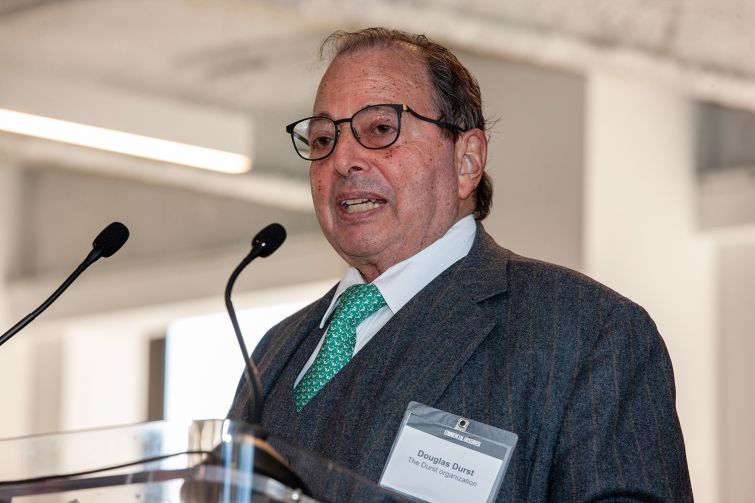New York’s Commercial Real Estate Market on the Mend: Forum
While no one in the industry will remember 2023 as a banner year, per the experts at a recent Commercial Observer forum, there have been — and are — bright spots
By Abigail Nehring and Tom Acitelli November 16, 2023 4:45 pm
reprints







Three years out from the pandemic, how you read the economic tea leaves for commercial real estate likely depends on what your own balance sheet looks like. But most people in the room at Commercial Observer’s Fall State of CRE forum would agree: Never bet against New York City.
That thesis was supported by the panoramic view of the Midtown skyline from the 43rd floor of the Durst Organization’s 1133 Avenue of Americas, where Observer Media CEO James Freiman took the podium to kick things off Nov. 14. It was a diaphanous autumn day, and an array of professionals in the field — owners, brokers, lenders, attorneys and city officials — gathered to winkle a sense of where things are headed in 2024.
“I’ve been in the business since John Lindsay was mayor,” said Durst Chairman Douglas Durst in opening remarks, referencing a man who left office in 1973. “I have read countless postmortem headlines about the city and our industry going back to the 1970s. And I can say with confidence that the conventional wisdom about commercial real estate today is dead wrong.”
Commercial real estate is not a monolith, Durst stressed. (At least two others would use “monolith” and “commercial real estate” in the same way throughout the forum.) While perhaps the iffiest realm of the Manhattan market — commodity office buildings — is suffering high vacancies, Durst said top-tier office towers “are performing exceptionally well, and I don’t just mean new construction.”
He cited the success of 1133 Avenue of the Americas itself, and of his company’s 2023 — which he said was one of the busiest leasing-wise in its 100-year history.
In the first panel discussion, on lessons learned from 2023, the audience heard from Durst Organization President Jody Durst, NYC Economic Development Corporation (EDC) Chief Operating Officer Melissa Román Burch, Nuveen Real Estate portfolio manager Pamela West, Columbia Property Trust President and CEO Adam Frazier and Acore Capital Senior Managing Director Eric Ramirez.. The panel was moderated by Fried Frank partner Michael Werner.
Román Burch laid out the city’s grand strategy for the “ ‘New’ New York” — a set of recommendations for economic recovery released in December 2022.
EDC is “the largest New York City real estate impact firm,” Román Burch said.
The plan includes updates to New York’s zoning resolution to enable more office-to-residential conversions, additional public-private partnerships that reimagine the public realm along certain key commercial corridors, and a new tax abatement to help landlords update office buildings to meet the needs of the new workforce.
“This isn’t a one size fits all,” Román Burch said. “We are going to need to make sure that owners have more options and more flexibility with their assets. Office to residential is not going to work for everyone, but it will work for some. So we need to put into the marketplace as many options as we can so that people can work through the additional vacancy at this time.”
Empire State Realty Trust Executive Vice President Thomas Durels, Durst Organization principal and Chief Development Officer Alexander Durst, HqO CEO Chase Garbarino and The Designers Group founder and CEO Blima Ehrentreu took the stage for the second panel discussion on planning the next 24 months. It was moderated by Kasowitz Benson & Torres partner David Kupfer.
Empire State Realty has seen seven consecutive quarters of positive absorption in a portfolio made up almost entirely of prewar buildings, according to Durels. He contended that the “flight to quality” approach is not the only path to success in New York’s post-COVID office market.
“We’re delivering what tenants, our customer, ultimately wants,” Durels said. “They want buildings that are modernized, amenitized, thoughtfully designed and functional spaces that are either prebuilt or turnkey for tenants, often fully furnished and wired.”
Related Companies CEO Jeff Blau took the spotlight next for a discussion on the state of New York City and other leading urban markets led by Davis Polk partner Brian Hirsch.
The redevelopment of Hudson Yards would never have succeeded if Related hadn’t been prepared to weather multiple downturns, Blau said. The company has become increasingly vertically integrated, which has acted as a buffer against shifting economic sands.
“We take more risks in order to manage risk,” Blau said. “And what does that really mean? It means that the only way to manage risk is to be in the weeds, in the details, and staying on top of things” instead of shifting risk to a third party.
The next panel, “The Converts: The Insider’s Perspective From the People Who Have Done It,” tackled the flavor du jour: converting underused office space into housing.
Moderated by CO Deputy Editor Tom Acitelli, the panelists included Jeff Gural, chairman of owner and developer GFP, and Nathan Berman, founding principal of developer MetroLofts. Their companies are behind the conversion of the 1 million-square-foot office building at 25 Water Street — previously known as 4 New York Plaza — in Lower Manhattan into 1,321 apartments.
Berman noted the challenges in converting the old 4 New York Plaza, which he likened to “a penitentiary.” The conversion involves creating two interior courtyards down to the second floor to allow more light into vast interior floor plates, reskinning the facade, and adding nine floors.
The conversion is unfolding in a neighborhood more familiar than most with office-to-residential conversions. Developers, bolstered by vast public subsidies, converted millions of square feet of Lower Manhattan office into residential 20 years ago.
“When things fell apart after 9/11, and a lot of these Wall Street tenants decided they’d rather be in Midtown, these downtown office buildings became obsolete,” Gural said. “The city and state did the right thing, and came up with this revitalization program where they gave tax incentives to convert these buildings.”
Gural’s company was involved in the conversion of 17 Battery into a partially residential building at the time. It was a project — like with 25 Water two decades later — that was fraught with challenges, including an office tenant that didn’t want to relocate in the building to make way for the conversion of its floor.
As for government sweeteners this time around, City Planning Director Daniel Garodnick, another panelist, said the city was working to get out of the way. The goal of the administration of Mayor Eric Adams is to broaden the umbrella under which buildings can be converted as of right.
“We have identified as the primary points of concern the date the building was constructed and where it’s located,” Garodnick said of rules regulating conversions. Buildings in areas such as Midtown and Lower Manhattan constructed after certain dates generally aren’t eligible for conversion, he noted.
Garodnick said the city is also working with state lawmakers to develop tax abatements similar to the expired 421a program to foster housing projects. It could be awhile, though. The City Council might not vote to change the eligibility period until next fall, for instance.
As for paying for all this conversion, it too is complicated. Numerous factors come into play, including existing tenancies and debt as well as the often fluctuating natures of budgets for conversions. Panelist Adam Piekarski, co-head of real estate credit at BDT & MSD Partners, said the initial decision to convert often simply comes down to value. And office values in New York and elsewhere are slipping.
“I think we’re undergoing perhaps the largest basis reset in office properties in the last 40 or so years,” Piekarski said.
To wrap up the day’s events, CO Editor in Chief Max Gross moderated a discussion on investment sales with PGIM Real Estate Executive Director Justin Levitt, Post Brothers Chief Investment Officer Zak Klinvex, and Ripco Real Estate Vice Chairman Stephen Preuss — who divulged some of the ins and outs of their recent deals.
PGIM is working to close a retail deal on Long Island and a student housing deal in the Midwest, Levitt said.
The amortizing debt-service coverage ratio for the student housing deal is close to 120, which is on the lower end, Levitt said, but that is partly because the asset class comes with “some seasonality and fluctuations in cash flow.”
Philadelphia-based multifamily developer Post Brothers has built about 5,000 housing units to date, Klinvex said.
It was painful to close a five-year CMBS refinance for another project last summer, he added, but the project’s construction loan was coming due and “we just kind of watched this race run away from us all summer.”
Post Brothers is staying active in the new environment, by Klinvex’s account.
“Fifteen years from now, we’re not going to look back and say, ‘Man, we should have waited a year to start that project.’ ”


